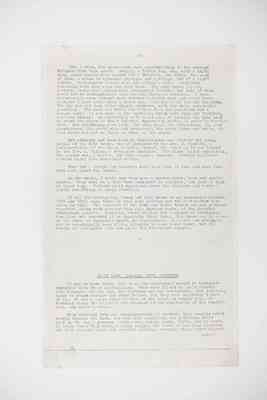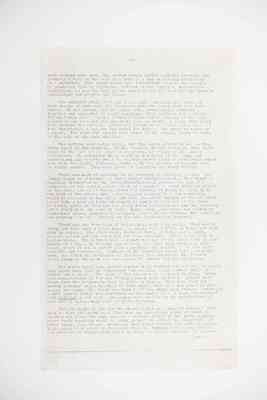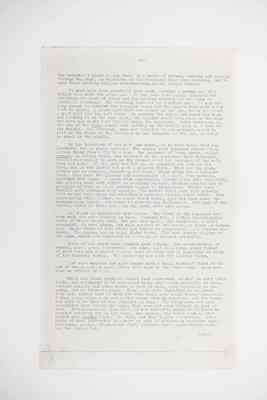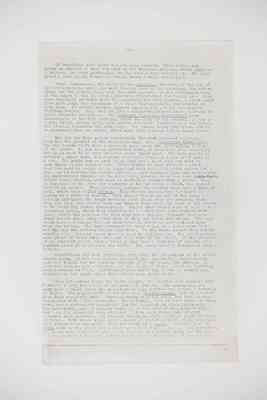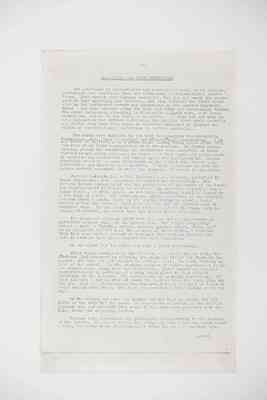Pages
6
-3-
Two, I knew, had noses much more approximating to the average European form than usual. [Dougal], a Yabber boy, who, with a white skin, would easily have passed for a European, and [Fanny], the wife of [Dick], a woman of splendid physique and carriage, and of a light colour. Half-castes favour most the father's side. Quadroons generally have blue eyes and fair hair. The long upper lip is, perhaps, their most soncpicuous aboriginal feature, but some of them could not be distinguished from swarthy European children. I have occasionally seen amongst pure natives a fairly high and erect forehead, but I have never seen a broad one, Usually it is low and receding. The eye was set deep under shaggy eyebrows, with the white invariably jaundiced. The nose was broad and rather flat but sometimes had a Jewish cast. It was wide at the nostrils, which were open and flexible, dilating freely. In conformity with their idea of beauty, the gins used to press the noses of their infants, especially girls, in order to flatten them. The cheekbones were high, the chin small and retreating, the jaws prognathous, the mouth wide and prominent, the teeth large and white, the lips heavy but not so thick as those of the negro.
Two attempts had been made to Christianise and educate the young people of the Kabi tribe, one at [Durundur] by the [Rev. D. MacNabb], a represesntative of the Roman Catholic Church, the other on [Frazer Island] by the [Rev. E. Fuller], a Methodist minister. The first failed absolutely, the second was, I believe, far from being a success. Perhaps different methods might have succeeded better.
They had a talent for mimicry, were very found of fu, and were free from care about the future.
On the whole, I would say they were a good-natured, kind and gentle people. They were as a rule very indulgent to children, and just as kind to their dogs. Fathers would sometimes nurse the children and carry a little straddling on their shoulder.
Of all the aborigines, young and old, known to me personally between 1865 and 1870, only three or four pure natives and two half-castes were alive in 1906. The remnats of the Kabi and Wakka tribes are now gathered together, along with natives from more distant parts, at the [Barambah aboriginal reserve]. Formerly, every station had a number of aboriginal families, who regarded it as specially their home. Now there are no camps on the runs, no organised hunts, no corroborees. A feeble old straggler may be occasionally seen alive, clinging to some loved haunt, but the centre of aboriginal life now is at the Government reserve.
DAILY LIFE, SHELTER, FOOD, CLOTHING
It may be mere fancy, but to me the aborigines seemed to harmonise admirably with their surroundings. They were fitted to their country like kangaroo and the emu, the platypus and the barramunda. Man generally seems to stand outside and above Nature, but they were decidedly a part of it. To see a large squad of them on the march in single file, or bounding along the hillside and shouting in the excitment of the kangaroo hunt, was quite a treat.
When shifting from one camping-ground to another, they usually moved slowly through the bush, the families seperating and gathering their food on the way - possums, bandicoots, honey, grubs, birds, and so forth. At other times they marched along singly, the lords of creation stepping out with elastic tread and graceful bearing, carrying their light weapons (over)
7
-4-
with perhaps some game, the weaker vessel loaded with the chattels and possibly a baby on the back in a loop of rug or sitting stride-leg on a shoulder. Some would carry live fire-sticks to save the trouble of producing fire by friction. Arrived at the familiar, well-chosen rendezvous, it was the duty of the women to cut the bark for the humpies (dwellings) and prepare the fires.
The ordinary style of house was a mere bark shelter. Three or four sheets of bark were set obliquely with the lower ends in a semicircle, on the ground, and the upper ends, overlapping, gathered together and supported by light saplings. This sufficed for a family The dewllings were placed with little distance apart, facing in the same direction and each had its own small fire in front. A large fire would have roasted the inmates. Grass was strewn on the floor for a bed. If rain threatened, a rut was dug round the back of the humpy to serve as a drain. The warriors' spears were stuck in the ground, ready to hand, at the side of the rude shelter.
The natives were astir early, but they could afford to be, as they often slept in the daytime. In the evening, before retiring, they would squat by the fire or lie awake discoursing, or indulging in a quiet corroboree. On occasions there would be bad blood in the camp, and accusations and retorts would be volubly poured forth in stentorian tones late into the night, followed, perhaps, by the clatter of weapons used in single combat. They were great at invective and wordy strife.
There was much of interest to be observed on visiting a camp. The family could be witnessed at their rather irregular meal. They might be regaling themselves on the eucalyptus-flavoured possum, the leg of a kangaroo, or the tender, white flesh of a snake. A joint would be placed on the fire, and as it became partially cooked, it would be taken up by the head of the house, who, after helping himself to a few mouthfuls, would be followed by his wife, and then one after an other of the children would take a bite in turn, whereupon it would be replaced at the fire. No doubt, eaten in this way the gravy would be delicious, and the adhering ashes would give the zest of salt. Large game, like emus, was cooked in improvised ovens, prepared by scooping a hole in the ground. The operation was nothing like so elaborate as the mode followed in Victoria.
There are two varieties of native bee, both very small. They had no sting and made only a faint hum. One kind, called killa in Kabi, was very dark in colour; the other kind, known as kavai in Kabi, was a light, greyish colour and its honey was the less esteemed. Their nests were in hollow trees. The natives made a spongy mat out of the inner bark or bast tissue of a tree, by beating and chewing it. The method [?] was very sociable and economical. Members of the household would take a suck in turn, and after the substance of the honey was exhausted, the flavour would cling to the bark rag and reward the sucker for his exertions.
The man's chief home duties consisted in cooking and eating. He would also spend much time in fashioning his weapons, using a stone knife or chisel and a shell. The ends of the spears were hardened by fire. Cords were manufactured of fur and of hair, human hair included. Sinews were drawn from the kangaroo's tail to serve as twine. They were used for sewing possums' skins together to form rugs. Mush time was spent in preparing the rugs. The flesh was rubbed off the skins with stones. Generally a rude linear design was scratched on the inside of [each?] skin and coloured with kuthing, a red clay. The women were skilled in the manufacture of nets and of dillie-bags made of grass or twine.
The men might go out for the chase either in a band or singly. They used to fire the grass in a line from one projecting point of scrub to another and force the game away to a corner, formed by the scrub margin, where their comrades would be lying in wait to effect the slaughter. At other times, just by loud shouting, they would confuse the mobs of marsupials, while they would be following them up, running with a long stride, and prepared to strike with spear or waddy as chance offered. It stirred (over)
8
-5-
the onlooker's blood to see them, in a state of nature, running and leaping through the bush, as wild-like as the creatures they were pursuing, and to hear their hunting halloes reverberating in the virgin forest.
It must have been painfully slow work, cutting a possum out of a hollow tree with the stone axe. It was less laboriously employed for stripping the bark of trees and for cutting notches for the toes to assist in climbing. The climbing vine was in constant use. It was cut long enough to compass the thickest trees and the user's body with a few feet to spare. A loose open knot was formed at one end, so as to afford a good hold for the left hand. By passing the other end round his back and holding it in the same hand, the climber could lean back on the vine and have his right hand free for using the tomahawk. Those dexterous in the use of the yuru, could walk quickly up the smooth stem of a tree to any height. The tomahawk, when not required to cut notches, would be held on the front of the shoulder by the pressure of the jaw, or would be stuck in the girdle.
In the territory of the Kabi and Wakka, as we have seen, food was plentiful and in great variety. The animal food embraced almost every living thing from a fly to a man. The presence of large grubs, called buruga, in living trees, was detected by the wood-dust they dislodged, which could easily be seen on the ground or at the entrance of the hole they had made. If the grub was far in, an incision was made in the tree, and it was picked out with a pointed stick. They ate the grub, either raw or roasted, rejecting the head. These grubs are a delicate food. They have the flavour and consistency of a soft, rice pudding, enriched with eggs. I speak from experience, having eaten them repeatedly. The natives were very expert in catching animals, knowing exactly how to get hold of them so as to prevent injury to themselves. Fresh-water turtles were captured very neatly. The native would swim very quietly till he got near where the creture's nose was visible above water. When approaching still closer, he would tread water, slip his hand under the unsuspecting turtle, and catch it without any difficulty. The eggs of the turtle, found in their holes in the bank, were also eaten.
All kinds of marsupials were eaten. The flesh of the kangaroo has very much the same flavour as beef. Possums have a rather objectionable taste of their staple food, the gum tree leaf. The bandicoot, a small marsupial, is very plump, and when roasted on the coals, as tasty as sucking pig. Snake flesh is very white and tender in appearance. All lizards were eaten. The goanna has an oily, fishy taste. The same remark applies to its eggs, which are deposited in a string in disused ant-hills.
Birds of all sorts were counted good eating. The scrub-turkey, or wawoon, was a great favourite. Its eggs, laid in a large mound formed of soft soil and withered leaves, were as large and as palatable as those of the domestic turkey. The boomerang was used for killing ducks.
Fish were speared and also caught with a small hand-net fixed at the end of two pieces of wood, which were held by the other ends. Eels were also an article of diet.
While all these kinds of animal food mentioned, as well as many other kinds, not necessary to be mentioned here, were eaten generally by some, certain animals and other kinds of food as well, were forbidden to the young, and at times to women. Thus, eels were forbidden to children. They were warned that if they ate them their nose would become cancerous. I knew a man whose nose was partly eaten away by gangrene, and the cause was said to be that he had indulged in eels. The young were not only prohibited from eating emu eggs, they were not even allowed to look at them. Infringement of this rule, it was believed, would be followed by pimples breaking out on the nose. One season, the women told me that bunyas were mundha (tapu), to them, and they begged for mutton. Other kinds of food proscribed to minors on pain of disease or sickness were, porcupine, snakes, fresh-water fish, kangaroo hurt, scrub-turkey eggs, and the flying fox.
(over)
9
-6-
Of vegetable food there was not much varity. Miss Potrie has given an account of what was used by the Brisbane natives, which applies, I believe, in every particular, to the tribes here treated of. She also gives a list of the botanical names, which I shall not repeat.
Yams, fern-roots, the root of the cunjevoi, the core of the top of the cabbage-palm, and a few wild fruits, such as the quandong, the native plum, and the native lime, were the most common. It was recognised duty of the women to dig the yams (Dioscorea Transversa) for family use. They were regularly provided with the yam-stick for this purpose, a staff about five feet long, the thickness of a stout walking-stick, and pointed at both ends. It served another purpose equally well, being the women's fighting weapon. They used it like a single-stick with great deftness in their feminine encounters. The cunjevoi (Alocasia Macrorhiza) grew luxuriantly in the Kabi country, about the beds of the creeks. It has a large, broad, glossy leaf, with stalks set close together in a big bunch, and closely resembles the Arum lily. The juice, being poisonous, had to be expressed from the roots, which were then roasted before being eaten.
But for the Kabi people especially, the most esteemed vegetable food was the product of the beautiful bunya tree (Araucaria Bidwillii). The top towers aloft like a graceful dome above the surrounding foliage of the scrub. So far as my experience went, it seemed to bear annually, but it is said to be most prolific every third year. The cone sometimes attains a great size, the maximum diameters being as large as 16 ins. by 9 ins. The seeds are an inch to an inch and a half long and half an inch thick at the thicker end. Their tissue is like that of a potato. When the seed is young, it is juicy and soft and it is eaten entire and raw. As it matures the embryo assumes a more definite form and is rejectedthe surrounding tissue, at the same time, bcomes drier and less palatable. Before being roasted, each seed is partially bruised with a stone. When it has been in the fire for a minute or two it gives a crack, the signal that it is cooked. They sometimes pounded the roasted seed into a kind of meal, which they call nyangu. They showed exceptional foresight in laying up a store of bunyas. They picked the seeds out of the cone, leaving untouched the tough envelope with which they are covered, then they put them into netted bags and buried them about the beds of the creeks to be ready for future consumption. Bunyas thus stored came to have a very offensive smell, which they imparted to all that came into contact with them. Still the natives ate them with great relish, although they made their breath smell much worse than if they had eaten raw onions. The ripe seeds have a resinous flavour when roasted, which is more decided when they are boiled. The best evidence of their value as a nutritious food was the way the natives throve upon them. In the bunya season they became visibly fat. Certain trees were claimed by individuals. The local natives were proud of their bunya tree and very fond of the fruit. At the prospect of an abundant yield, tribes would gather from a distance of upwards of a hundred miles to feast upon the bunya. The visit usually terminated with a battle.
Cannibalism had been practised, but after the prejudices of the whites became known, it was very rarely indulged in. Apparently, human beings were not killed for the express purpose of being eaten, but portions of deceased persons not emaciated, and the flesh of those killed in fighting, were consumed as food. Individuals were unwilling to own to cannibalism themselves, but would admit that others were given to it.
When not moving among the white people, the natives were content with Nature's livery for clothing and were not ashamed. The possum rug was worn ike a shawl about the shoulders in cold weather and formed a covering at night. The papery bark of the tea tree (nambur nambur, had at a former time been similarly used. Other clothing they had none, but they adorned themselves with a few ornaments. Thier[sic] girdle, made of hair twine or other cord, was a convenient receptacle for the tomahawk or other implement. The head-band, also of plaited cord, or of the skin of the dingo's tail, was more for adornment than utility. I have seen those made of cord coloured with pipeclay. On special occasions white feathers would be stuck in front. Both sexes would wear a piece of mother-of-pearl shell suspended by a string from the neck; this was known as a dulin. Another kind of dulin worn by the women was a piece of native dogskin cut in the posterior. The women wore long necklaces of beads made of a yellow reed, and the men had the septum of the nose perforated to hold a thin piece of bone or wood.
(over)
10
-7-
MAN-MAKING AND OTHER CEREMONIES
The practices of circumcision and subincision were, in my opinion, introduced into Australia from the north-west in comparatively recent times. They spread over Central Australia, but did not reach the southwest of West Australia nor Victoria, and they affected New South Wales only on the north-west corner and Queensland on the western boundary. These [rites?] were unknown among the Kabi and Wakka and surrounding tribes. The other ceremonies attending initiation to manhood were, with local variations, common to the whole of Australia. If they had not been so long disused in the settled districts, the details there would probably not differ very much from those so minutely described by Spencer and Gillen as characterising initiation in Central Australia.
Two words were employed by the Kabi to designate the man-making ceremonies, viz., Dhur (a circle) and Kīvar-yengga (man-making). I am not aware of initiation on a grand scale having taken place after 1865, the date of my first acquaintance with the natives. In former years, special places for conducting the ceremonies were selected, on which various tribes would converge, in order that they might all participate by contributing candidates and assisting in the performances. Places specially named to me were Boobangery on the Yabber run, Waraba near Caboolture, and Biuoraba near Ipswich. I shall endeavour to fuse together several accounts, in which the sequence of events is uncertain.
Certain individuals, called Kamaran, i.e., headmen, qualified by their experience, were appointed to conduct the proceedings. The various tribes camped apart and the initiation of the youth of one tribe was superintended by Kamaran of another. An essential requisite was a large circle, or Dhur, which, as was done elsewhere, would be formed by a low bank of earth. The proceedings, which, according to one account, covered about a month, begin by the youths having to spend a night camped within the circle. They have no fire but are allowed rugs of kangaroo skin. In the morning they arae taken out of the ring, each in charge of Kamaran, who watch them and direct their movements.
The women are camping apart from the men and no intercourse is permitted between them and the novitiates. The latter frequently repeat a spell - "Ngudha, ngudha, ngudha, ngudha, mīnya, mīnya, ka!" As my informant did not know the meaning of these words, I conclude that they were either corrupt or borrowed from another dialect, or else so archaic that their meaning had been forgotten.
On the first day the older men hold a grant[grand?] corooboree.
While being conducted by the Kamaran, if a snake is met with, the Bondaban (bull-roarer) is whirled, the snake is killed and shown to the youths, but they are not allowed to partake of it. In fact, fasting is part of the ordeal. In the evening, samples of mundha (prohibited food) are handed round among them for inspection. Their hunger is appeased surreptitiously by portions of possum being given to them without knowledge of the Kamaran. The concealment is probably fictitious. At this juncture a rug is wrapped about the head to hide the youth from the old men, just as mother-in-law and son-in-law cover the head at times to avoid seeing each other. The boys are prohibited from looking up at the sky.
On the second day they are washed and the hair is shaved off all parts of the body but the head. In some parts of Australia the hair is plucked out, and probably this would be the primitive practice with the Kabi, Wakka and adjoining tribes.
Various fire ceremonies are performed, corresponding to th Engwura of the Arunta. In one of these, the young men join hands and march round a fire, the yound[sic] women simultaneously doing the same at another fire.
(over).
